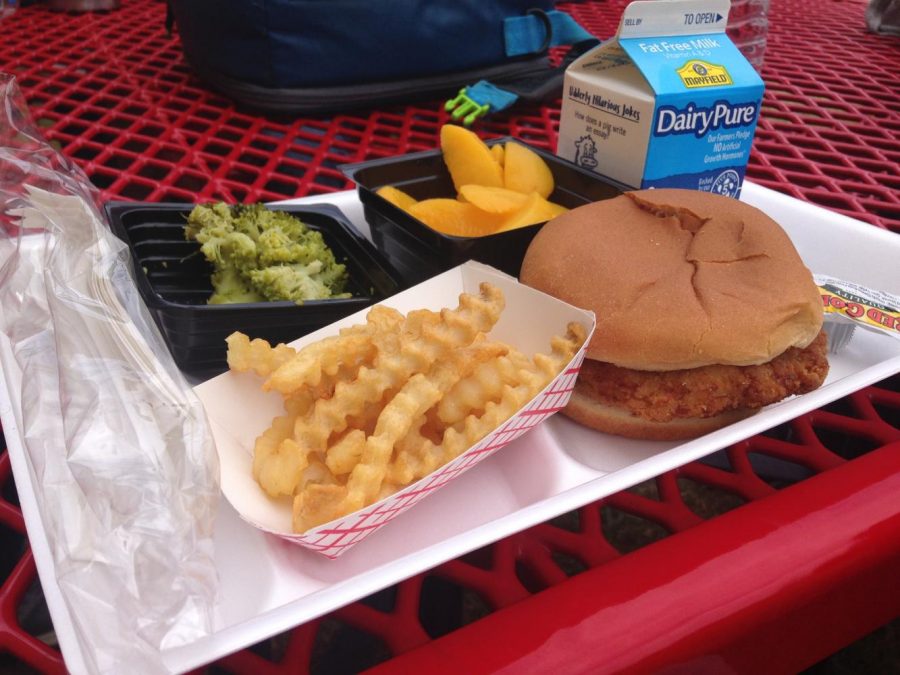Lambert’s Environmental Footprint
A typical meal available at Lambert on top of a polystyrene tray used by the school.
September 20, 2017
Students flood into Lambert’s cafeteria and form into lunch lines as servers quickly grab tray after tray to place hot food on. After one use, trays and any leftover food are thrown away by students. Dozens of trash bags are hauled to big blue dumpsters, where they wait to be sent to landfills. The vicious cycle begins all over again the next day.
On average, 850 students at Lambert High School buy lunch from the school’s cafeteria every day. Lunches are distributed on a white polystyrene foam, better known as the brand name Styrofoam™, tray. These trays are lightweight, and convenient to use for both the cafeteria staff and the students. Last school year, Lambert students used approximately 153,000 trays. Although convenient, the polystyrene trays are accompanied by many underlying environmental risks and concerns.
There are several factors that makes polystyrene foam incredibly flawed. One of the most concerning is the fact that polystyrene foam never decomposes; instead it photodegrades – a process in which the sun breaks an object down into smaller and smaller pieces of itself instead of naturally breaking down into simpler compounds. In addition, a major component of polystyrene is a chemical called styrene which is recognized as a carcinogen by the National Toxicology Program Center in its 14th Report on Carcinogens. While it’s unlikely that a consumer would be physically exposed to this chemical from a polystyrene product, workers who manufacture such products – and have been exposed to styrene in such chemical conditions – have been found to develop respiratory and eye irritation and even damage to the nervous system. This consequence reveals that there the harmful threats from polystyrene foam goes beyond environmental impacts.
Moreover, the process of recycling polystyrene foam is viewed as too expensive because polystyrene is lightweight and most recycling companies determine profit by weighing materials they receive. In addition to this obstacle, once the material is contaminated with food, recycling companies decline to recycle it; meaning all lunch trays are fated to landfills. A report by the New York City Sanitation Department has found that “Food Service Foam” cannot be recycled economically or in “an environmentally impactful way.” The report also found any polystyrene foam that made it through the sorting process of recyclable materials was later sent to landfills as no recycling company would buy it from the city. This finding by the sanitation department clearly demonstrates polystyrene just isn’t recyclable.
In recognizing the unsustainability of polystyrene, cities and states throughout the country are continuing to cut down usage of polystyrene trays. In 2014, Washington D.C passed a law banning polystyrene take out containers and a New York City law is expected to come into effect in November of this year. However, in June, California’s Congress rejected a bill to implement a statewide ban on polystyrene take out boxes.
Since it’s founding in 2009, Lambert has used approximately 1,224,000 polystyrene trays. This means a million trays are either sitting in landfills or have been burned. The trays undergoing photodegradation in landfills have likely given off thousands of millions of particles of polystyrene that sitting in landfills throughout the Suwanee and Duluth area.
This issue is larger than Lambert, and larger than Suwanee; pollution affects all of Forsyth County. All five Forsyth County high schools – with a combined population of 13,349 – use the polystyrene foam trays. It is worthy to note elementary schools in Forsyth almost always use hard reusable plastic trays.
However, it would be not only impractical for Lambert to switch to hard reusable plastic trays, but also nearly impossible. Andrea Perkins, the assistant director of the Forsyth School Nutrition Program explains, “[A] school must have a quantity of trays to equal about 60% of student meal participation so they have enough trays to serve meals while the previous lunch group is still eating and the trays from the meal period before that are being washed.
“[Lambert] would need at least 510+ washable trays at a minimum initial purchase cost of $4,770, but our experience has been that students often throw away the washable trays (as if they were disposable), so a significant number of trays have to be replaced each year at a considerable cost.”
Reusable plastic trays also require the plumbing infrastructure for dishwashers and cleaning agents. The amount of gallons of hot water needed to wash over 500 trays daily would make this alternative less eco-friendly than it sounds on the surface.
This leaves the only other plausible green alternative to be decomposable trays.
Major school districts across the country, from Miami to Los Angeles have joined together to form the Urban School Food Alliance with a goal to “drive quality up and costs down while incorporating sound environmental practices.” This alliance has switched from polystyrene foam trays to decomposable trays made from recycled newspaper. The New York City School District has even begun to implement a compost system on school grounds.
Lambert’s contribution to pollution is unacceptable and a pilot program testing out the use of decomposable trays on school grounds would be the first step in creating a sustainable solution to ceasing the use of polystyrene foam.










